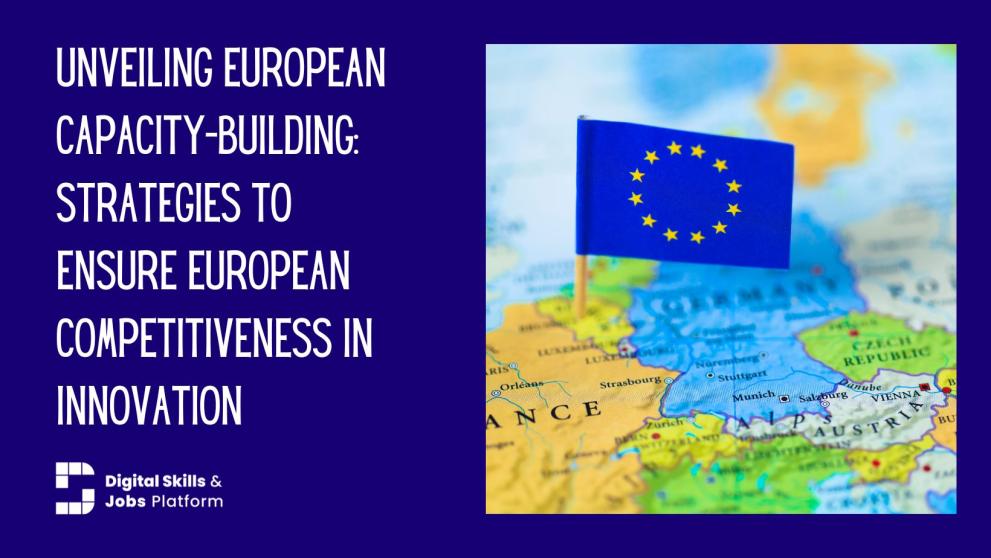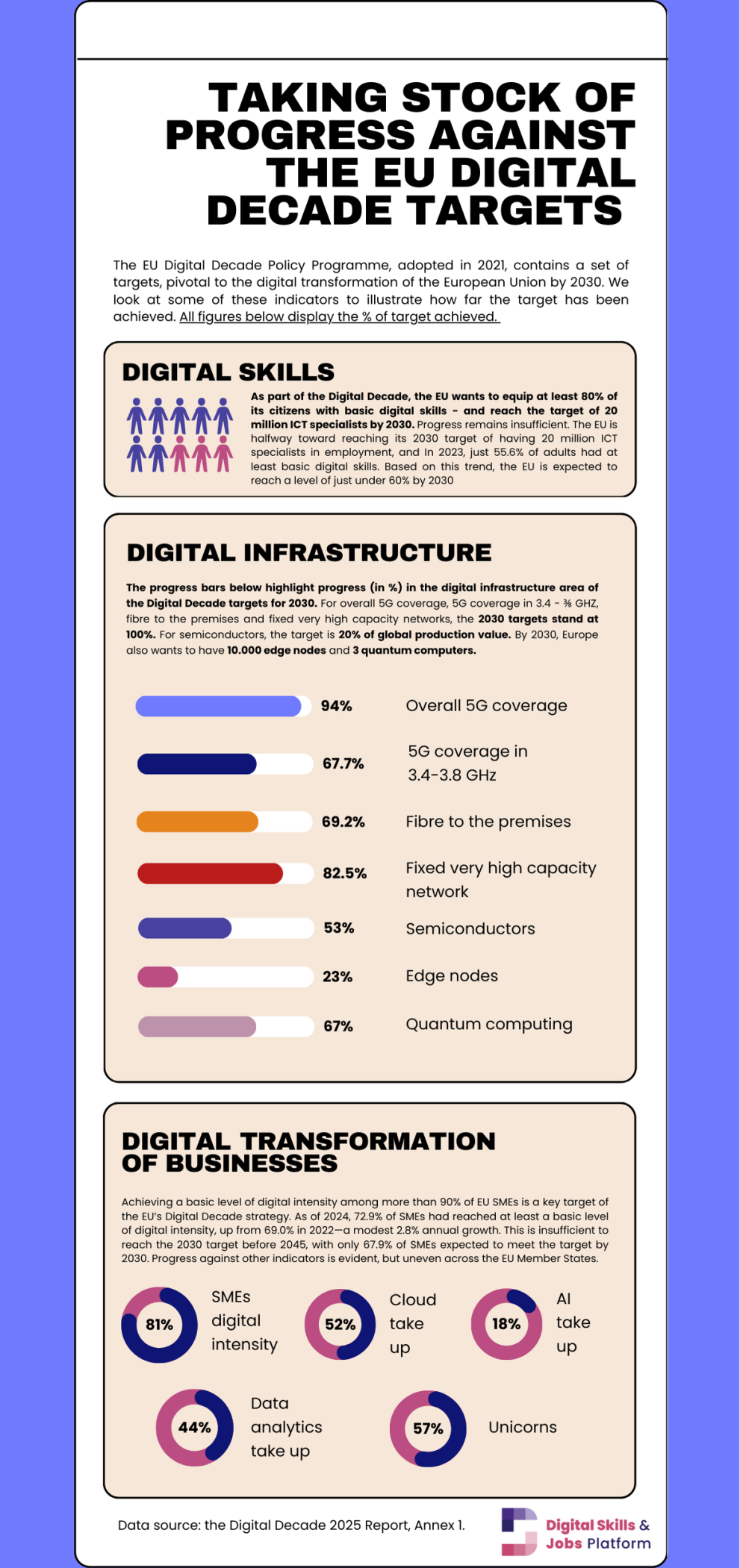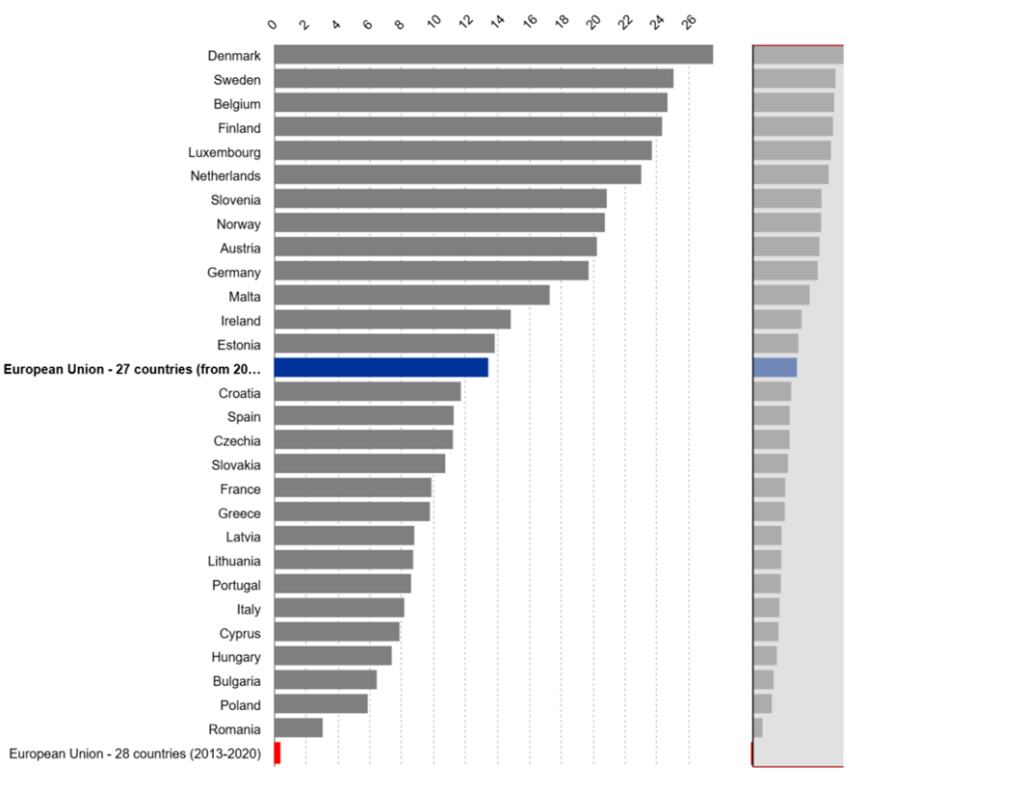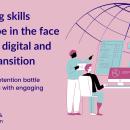Unveiling European Capacity-Building: Strategies to Ensure European Competitiveness in Innovation (deep-dive)

In an era of accelerating global competition, digital transformation, and technological disruption, Europe stands at a crossroads. To remain competitive and resilient, the European Union must invest not only in advanced technologies but also in the capacity of its people, institutions, and infrastructure to drive innovation and adapt to change. This brief explores Europe’s strategic efforts to strengthen its innovation ecosystem through coordinated investment in digital infrastructure, public-private collaboration, research-industry alignment, and targeted upskilling initiatives. Drawing on the latest policy frameworks—including the Digital Decade Programme, Horizon Europe, and recommendations from the Letta Report—it highlights how digital capacity-building is being positioned as a cornerstone of Europe’s economic and social future. From bridging rural broadband gaps and scaling digital innovation hubs to introducing a “fifth freedom” for knowledge mobility and building pan-European data and research platforms, the article examines key policy tools and investment priorities. It also addresses the urgent need to attract global talent, reform research careers, and close the digital skills gap, ensuring all citizens benefit from the digital and green transitions. Read the full brief to discover how the EU can turn knowledge, diversity, and cooperation into lasting competitive advantage on the global stage.
Keywords
Digital Transformation, Innovation Ecosystems, Capacity Building, Public-Private Partnerships, Talent and Skills Development.
Introduction
Europe is facing a defining moment. As global competition in technology and innovation accelerates, Europe must urgently strengthen its strategic foundations by investing in skills, attracting talent, and creating future-ready jobs. To secure its competitiveness, Europe must upgrade digital infrastructure, support cross-sector collaboration, and align academic research with industrial needs. This article explores strategic approaches to scale innovation, drive knowledge transfer, and attract global talent through coordinated EU-wide initiatives, public-private partnerships, and workforce upskilling programs.
Digital Infrastructure as the Backbone of Innovation
In a knowledge-driven economy, digital infrastructure plays a critical role. According to the European Commission’s 2025 State of the Digital Decade report, very high-capacity networks (VHCNs) cover 82.5 % of EU households, only 69% of EU households have access to fibre, and high-quality 5G coverage (in the key 3.4–3.8 GHz band) remains at 67.7%. In addition, significant disparities remain, particularly in rural and cross-border regions.
To bridge existing gaps, the Connecting Europe Facility (CEF2 Digital), the Recovery and Resilience Facility (RRF), and the European Regional Development Fund (ERDF) provide crucial support. These mechanisms finance broadband rollouts, 5G corridors, and cloud-edge computing deployments, which are vital for Industry 4.0, smart mobility, smart communities and digital innovation ecosystems.
One of the key challenges Europe faces in digital infrastructure and electronic communications is significant market fragmentation. The Letta Report (2024) adds urgency, calling for a true Single Market for electronic communications to overcome fragmentation. The European Union has 34 mobile network operators serving a total of around 170 million users, an average of 5 million per operator, compared to just 4 operators in China serving 467 million users and 3 in the U.S. serving 107 million.
Such fragmentation creates barriers to investing in next-generation networks like 5G and 6G, undermining Europe's capacity to innovate and lead in digital transformation. As a way forward, the report recommends aligning spectrum policies, harmonising net neutrality rules to enable 5G slicing (multiple virtual networks running on the same physical 5G infrastructure), and creating a pan-European telecom regulatory framework to achieve economies of scale and accelerate innovation in AI, quantum technologies, and the Internet of Things.
Fostering Strategic Collaboration and Ecosystems
Europe's strength lies in its diversity and collaborative culture. However, Europe’s fragmented innovation ecosystems need scale and strategic alignment. Large-scale funding programs on EU level like Horizon Europe, the Digital Europe Programme, and the Interregional Innovation Investments Instrument (I3) support cross-border R&D and commercialisation. EU missions and partnerships, such as the European Innovation Council (EIC) and the European Institute of Innovation and Technology (EIT), play a key role in supporting breakthrough innovations, scaling startups, and fostering transnational ecosystems.
Moreover, the recent development of European Digital Innovation Hubs (EDIHs)—now established in 90% of EU regions—aims to equip small and medium-sized organisations (SMEs) and public sector actors with access to testing facilities, skills development, training opportunities, and financial support. By acting as one-stop shops, EDIHs enable local capacity-building while connecting regional actors to the wider EU digital innovation network.
Additionally, three newly established European Digital Infrastructure Consortia (EDICs), with eight more in preparation, aim to foster cooperation and streamline the launch and implementation of multi-country projects in areas such as language technologies, blockchain, and digital twins.
The Letta Report introduces the concept of a “fifth freedom” in the Single Market i.e. free movement of knowledge, research, and innovation, positioning it alongside the traditional four freedoms: goods, capital, services, and people. Enrico Letta argues that in the 21st century, Europe's competitiveness depends as much on the flow of ideas, talent, and data as it does on physical goods and services, therefore calls for the removal of barriers that hinder cross-border collaboration in research, the mobility of researchers and innovators, and the exchange of scientific data and results. This would involve harmonising rules for research funding, creating interoperable digital platforms for data sharing, promoting open science, and facilitating academic-industrial partnerships across Member States.
The “fifth freedom” is thus envisioned as a political and economic enabler of a more integrated European Research and Innovation Area—where talent circulates freely, research infrastructure is shared, and innovation can scale across borders as easily as products and services do today.
To enable large-scale innovation, Letta proposes the creation of a “European Knowledge Commons,” a pan-European digital platform for sharing publicly funded research and data. He also calls for a common governance model for data spaces and cloud infrastructures to enable trust and interoperability.
Bridging Academia and Industry: From Knowledge to Market
Despite world-class researchers and research outputs, Europe struggles to commercialise its academic innovations. The European Research Area (ERA) policy agenda has prioritised stronger links between knowledge generation and application.
National Digital Decade roadmaps, backed by EUR 251.9 billion in investments, contain over 1,600 measures targeting semiconductors, AI, and skills. However, only 52% of national targets align with EU objectives, prompting calls for better coordination and stronger implementation mechanisms.
EU instruments like the Knowledge Valorisation Platform, the ERA Hubs, industrial PhD schemes and the European Framework for Research Careers aim to bridge this gap and promote technology transfer, intellectual property (IP) management, and collaborative research. Letta further recommends pan-European research infrastructure sharing, quantum investments, and open-access IP regimes.
National and regional innovation agencies are also encouraged to incentivise co-publications, joint labs, and mobility schemes between universities and enterprises.
The proposed European Framework for Research Careers (EFRaC) will further align academic incentives with innovation goals, making research careers more attractive and entrepreneurial.
Upskilling the Workforce for Innovation Leadership
A digitally skilled and innovation-ready workforce is essential for Europe’s competitiveness. Letta stresses that digital and STEM upskilling is not just a social policy but a competitiveness imperative.
Yet, Eurostat, the Statistical Office of the European Union has measured that only 55.6% of the EU population aged 16-74 has basic digital skills, which is far below the 2030 80% target. Moreover, the first State of the Digital Decade report showed that the number of ICT specialists is projected to reach 12 million by 2030, still 8 million short of the goal.
The Pact for Skills (one of the flagship actions of the European Skills Agenda), Erasmus+ Alliances for Innovation, and the Digital Europe Programme’s Advanced Digital Skills actions are helping reskill workers in AI, cybersecurity, data science, and high performance computing (HPC). The Structured Dialogue on Digital Education and Skills, launched in 2023, has created stronger synergies between national strategies and EU support. These efforts are further complemented by the Digital Education Action Plan (2021–2027), which provides a high-level strategic framework to support the development of digital skills and infrastructure across education systems in Europe.
Industry-led initiatives such as the European Software Skills Alliance (ESSA) and public-private alliances for micro-credentials are improving agility in lifelong learning and workforce responsiveness. These initiatives are helping to bridge the gap between rapidly evolving industry needs and the slower pace of formal education systems by offering modular, targeted training that can be quickly adapted to technological and labour market changes.
ESSA, for instance, brings together industry, education providers, and policymakers to define skills frameworks and design training pathways that directly reflect the real-world requirements of software and digital professions. Meanwhile, alliances promoting micro-credentials enable learners—regardless of age or background—to acquire specific competencies through short, recognised learning units that are stackable and transferable across sectors and borders.
Together, these efforts support lifelong learning, empower workers to upskill or reskill in real time, and help SMEs and large enterprises alike respond more effectively to the demands of the digital and green transition. Emphasis is increasingly placed on inclusiveness—ensuring women, youth, migrants and underserved regions benefit from innovation-driven growth.
Attracting and retaining global talent
To compete with the U.S and Asia, Europe must become a magnet for global talent, especially in areas like science, technology, and innovation. The European Research Area (ERA) and the Talent Booster Mechanism aim to improve researcher mobility, reduce brain drain, and attract top researchers from outside the EU. These efforts are further supported by the New European Innovation Agenda, a flagship initiative driving innovation and talent attraction across the continent. The upcoming European Framework for Research Careers, along with reforms to the Blue Card and national talent visa schemes, supports this ambition by offering more attractive conditions for international researchers and innovators.
Several national governments are already taking bold steps. In response to growing concerns among U.S. scientists during the Trump administration, France launched the “Make Our Planet Great Again” initiative, offering competitive grants and relocation packages to attract climate researchers and scientists in sustainability-related fields. Building on this, France recently introduced the “Choose France for Science” platform, enabling institutions to propose projects in key areas such as health, climate change, AI, and digital systems, further demonstrating France’s commitment to scientific excellence.
Germany is also actively seeking to attract international researchers. The German government has initiated the “1,000 Experts Programme” and the Meitner-Einstein Programme, aiming to bring top, early-career researchers and academics to Germany, particularly those from the U.S. who are facing challenges in continuing their work due to funding cuts or policy changes. Additionally, the Max Planck Society's Transatlantic Programme offers opportunities for U.S.-based scientists to collaborate with German research institutions. These efforts are complemented by regional initiatives, such as Berlin's fund to support research institutes in recruiting international talent.
Beyond mobility, creating innovation-friendly ecosystems is equally essential. Europe must offer clear career progression pathways, strong IP frameworks, and sustained R&D investment to retain and empower the talent it attracts. To address systemic barriers, Letta’s “fifth freedom” and the proposed “European Degree” aim to remove legal and institutional obstacles to cross-border academic and research careers. He also calls for pan-European research infrastructures, a simplified talent visa framework, and innovation-friendly regulatory sandboxes to foster experimentation and scale-up potential.
Moreover, Letta proposes a significant boost in funding for European Universities alliances (to €600 million annually) and a universal youth mobility program, ensuring that every student under 18 gains access to international learning opportunities. This dual approach—“freedom to stay” and “freedom to move”—is designed to make Europe not just a destination for top global talent, but a lifelong innovation ecosystem for future generations.
Governance and Monitoring for Long-term Impact
Robust governance and coordinated monitoring mechanisms are essential to ensure Europe’s long-term innovation competitiveness. The Digital Decade Policy Programme (DDPP) provides a structured, forward-looking framework for steering and evaluating the EU’s progress toward its 2030 digital objectives. Annual country reports, national Digital Decade strategic roadmaps, and multi-country project governance mechanisms enable both accountability and course correction.
Complementary tools like the European Innovation Scoreboard and the Regional Innovation Scoreboard offer detailed benchmarking across Member States and regions, highlighting strengths and innovation gaps. These data-driven instruments are vital for evidence-based policymaking and for tailoring investments to local needs and capacities.
However, the 2025 State of the Digital Decade Report reveals significant shortfalls in critical areas, including AI adoption, SME digital capabilities, and the use of cloud technologies. For example, 50% of EU companies currently use data analytics, and AI adoption remains stagnant (17%). Since 2024, the pace has accelerated — but it remains uneven across the EU (see the infographic below for an illustration of this).

The 2025 report therefore calls for reinforcement—more investments, streamlined regulation, and improved access to funding for SME. Without accelerated intervention, the EU risks falling behind in the global innovation race.
Figure 2 below depicts the share of companies in some EU countries for 2024 that use at least 1 AI technology (Eurostat, 2024).

To address these challenges, capacity-building must be treated as a strategic investment, not only in infrastructure and talent but also in institutions, governance processes, and cross-sectoral collaboration. This requires a whole-of-government and whole-of-society approach.
Key strategies to reinforce governance and competitiveness include:
- Policy coherence across digital, cohesion, research, and industrial strategies, ensuring alignment of funding, regulation, and innovation missions.
- Multi-level governance that actively involves local and regional authorities, universities, SMEs, and civil society, thereby ensuring territorial inclusiveness and ownership of reforms.
- Dedicated capacity-building funds and technical assistance, including through the Technical Support Instrument and the proposed PEACE Facility (Public Empowerment and Administrative Capacity Enhancement) as suggested in the Letta Report.
- Common European frameworks for innovation policy coordination, building on the success of the European Research Area (ERA), and fostering agile cooperation through joint programming and mission-oriented governance.
Moreover, the Digital Decade’s governance cycle must evolve to become not just a monitoring tool, but a strategic driver of systemic reform. This includes linking the Digital Decade targets more closely with broader EU strategic priorities—such as the Green Deal, open strategic autonomy, and the European Education and Research Area.
Conclusion
European competitiveness in innovation depends not only on technology and investment, but fundamentally on its people—their skills, creativity, and capacity to turn knowledge into progress. As the global race for talent, technology, and strategic influence accelerates, the EU must seize this moment to transform its structural strengths into a lasting competitive edge.
The current geopolitical landscape, marked by shifting alliances, growing instability, and intensifying global competition, offers a powerful momentum for Europe to act with greater unity and ambition. It is in this context that the EU must reinforce its digital infrastructure, deepen collaboration across borders and sectors, and prioritise the development and mobility of its human capital.
By leveraging EU-wide mechanisms, fostering public-private partnerships, and closing the gap between knowledge generation and application, Europe can build an innovation ecosystem that is not only inclusive and resilient but globally relevant. The Digital Decade strategy and Letta’s proposed “5th freedom”—the free movement of knowledge, research, and innovation—together provide a roadmap for both systemic reform and visionary leadership.
From smart regions to world-class research infrastructures for AI and quantum computing, from digital skills to lifelong learning, every investment in people and ideas is an investment in Europe's future. Operationalising this vision means removing regulatory fragmentation, aligning incentives, and creating enabling environments where innovation can flourish—at all levels of society.
Now is the time for Europe to act not as 27 separate innovation systems, but as one powerful engine of sustainable growth, ethical technology, and global influence. Only by turning its values such as openness, cooperation, diversity and inclusion into structural advantages, can the EU thrive in a fast-changing world and secure prosperity, resilience, and sovereignty for generations to come.
Further reading
Check out the full paper, together with its references, on "Unveiling European Capacity-Building: Strategies to Ensure European Competitiveness in Innovation" in PDF format via this link. You can also view the infographic, again in PDF format, via here.
Author's biography
Dr. Emilija Stojmenova Duh is an associate professor at the Faculty of Electrical Engineering, University of Ljubljana, and former Minister for Digital Transformation of Slovenia. Her work bridges academia, innovation, and policy, with a strong focus on sustainable and inclusive digital development. A 2024 GovInsider “100 Women in GovTech” honouree, she leads the 4P Digital Innovation Hub and has spearheaded numerous national and European research and development projects, particularly in rural development, open innovation, and co-creation. She is a member of the Global Young Academy and an active member of UNESCO’s Women in Ethics in AI group. Emilija also serves as Chair of the European Interoperability Framework Informal Expert Group. Her research spans digital equity, rural transformation, and public-private-people partnerships. She is a former HiddenNoMore fellow, supporting women in STEM leadership through the U.S. IVLP.









